 A friend from out of state visited us in New Jersey. Having recently returned from Greece, we were still infatuated with the food there and decided to make dolmas and spanakopita with garlic roasted potatoes (although we didn’t consume any of these foods in Greece). Concerned about boiling the baby in the mother’s milk, I wondered if my observant friend could have my homemade tzatziki with dinner. “No problem,” he announced, I’ll just eat the spanakopita with tzatziki first, and then eat the dolmas. Reminded at this moment of these food rules I couldn’t decide if I found this response to be absurd or hilarious. One thing I knew for sure is that I regarded rules like this with contempt. Then things went bad. Upon observing that my egg-lemon sauce contained both butter and chicken stock my friend explained that it would be “for you all to enjoy, not me.” To me, this was unforgivable, a transgression I couldn’t overlook and one that still haunts me today. Egg-lemon sauce in my world has one job—singular and precious—and that’s to be ladled over dolmas (OK, and grilled salmon and asparagus). That any soul, in any world, isn’t allowed to drench dolmas in that nearly golden sauce is criminal. No, it goes beyond criminality and into transcendentalism. For me, it poses a fundamental question: is being Kosher really worth it in this world or any other? And I’m not even going into the obvious fact that the pig is the single greatest animal to eat, at least in this world. Maybe I’ll understand it one day. But I doubt it. If pigs rule the afterworld, I will be at peace in purgatory.
A friend from out of state visited us in New Jersey. Having recently returned from Greece, we were still infatuated with the food there and decided to make dolmas and spanakopita with garlic roasted potatoes (although we didn’t consume any of these foods in Greece). Concerned about boiling the baby in the mother’s milk, I wondered if my observant friend could have my homemade tzatziki with dinner. “No problem,” he announced, I’ll just eat the spanakopita with tzatziki first, and then eat the dolmas. Reminded at this moment of these food rules I couldn’t decide if I found this response to be absurd or hilarious. One thing I knew for sure is that I regarded rules like this with contempt. Then things went bad. Upon observing that my egg-lemon sauce contained both butter and chicken stock my friend explained that it would be “for you all to enjoy, not me.” To me, this was unforgivable, a transgression I couldn’t overlook and one that still haunts me today. Egg-lemon sauce in my world has one job—singular and precious—and that’s to be ladled over dolmas (OK, and grilled salmon and asparagus). That any soul, in any world, isn’t allowed to drench dolmas in that nearly golden sauce is criminal. No, it goes beyond criminality and into transcendentalism. For me, it poses a fundamental question: is being Kosher really worth it in this world or any other? And I’m not even going into the obvious fact that the pig is the single greatest animal to eat, at least in this world. Maybe I’ll understand it one day. But I doubt it. If pigs rule the afterworld, I will be at peace in purgatory.
 And there are other problems. While Bill Buford observes that vegetarians actually think more about meat and where it comes from than do carnivores (whom tend to think about meat as “an element in a meal . . . [e.g.] ‘what I want tonight is a cheeseburger!’”), there is still confusion lurking just under the veg surface. Kel and I went to have drinks and avocados with friends. We had vodka and they drank wine and beer. Two of them had just returned from Montreal. We were excited to ask them the typical questions. How was the train ride? How was the bed and breakfast? How was the exchange rate? Was it expensive? We asked about those kinds of things. But we were saving the most important and exciting question for last. “Talk about the food,” I requested dramatically. Five seconds into their answer, and I remember it like it was yesterday, they disclosed that they had recently “become” vegetarian. Almost reflexively I checked out of the conversation and worried that my disdain would be too obvious and rude as they went on about the “vegetarian Japanese restaurant” that they enjoyed and the other, meatless products they consumed. Vegetarian Japanese? Aren’t the Japanese best known for their seafood, beef, and pork? Their response had suddenly become stultifying, my frustration at this point tangible. What better way to make a food story uninteresting than by eliminating the eating of animals from it? I can’t really think of one.
And there are other problems. While Bill Buford observes that vegetarians actually think more about meat and where it comes from than do carnivores (whom tend to think about meat as “an element in a meal . . . [e.g.] ‘what I want tonight is a cheeseburger!’”), there is still confusion lurking just under the veg surface. Kel and I went to have drinks and avocados with friends. We had vodka and they drank wine and beer. Two of them had just returned from Montreal. We were excited to ask them the typical questions. How was the train ride? How was the bed and breakfast? How was the exchange rate? Was it expensive? We asked about those kinds of things. But we were saving the most important and exciting question for last. “Talk about the food,” I requested dramatically. Five seconds into their answer, and I remember it like it was yesterday, they disclosed that they had recently “become” vegetarian. Almost reflexively I checked out of the conversation and worried that my disdain would be too obvious and rude as they went on about the “vegetarian Japanese restaurant” that they enjoyed and the other, meatless products they consumed. Vegetarian Japanese? Aren’t the Japanese best known for their seafood, beef, and pork? Their response had suddenly become stultifying, my frustration at this point tangible. What better way to make a food story uninteresting than by eliminating the eating of animals from it? I can’t really think of one.
Now, in fairness, vegetarians are generally kind, well-meaning people. And the arguments for vegetarianism—on health, on wellness, on ecology, on economy, on morality, and probably on hundreds of other things—are legion. But, from a foodie perspective, vegetarianism profoundly limits what and how we think about food and the richness of the ways we can talk about it. And obviously the practice limits the ways we can enjoy food tastes and textures. And vegetarianism, as we know it in the Western world anyway, is more often than not caught up in a sort of bourgeois fantasy. Rather than a style of eating by virtue of necessity—poverty—being vegetarian in the West usually requires an elevated socio-economic status. Vegetarian foods, for the typical professional urbanite anyway, come from high-end, specialty outlets (even by Western standards). Most people in the world would never, ever, even think about shopping at a Whole Foods or a Trader Joe’s. And most people in the world cherish meat because of its preciousness and its singular and sublime, spiritual and physical, connection to the cycle of life. Let me paraphrase Anthony Bourdain; most of the people in the world are vegetarian, and they ain’t happy about it.
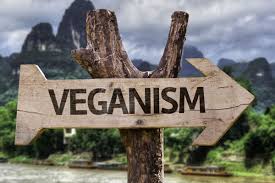 Finally, vegetarianism in its most fanatical form is called “veganism.” This fantastical human invention is a very small step away from not eating at all. I recognize that this is a realm of theory and practice that exists in another dimension entirely—familiar to only a tiny fraction of a percentile of people on earth—and one that I’ll never understand. But I also recognize that there must be a reason that no civilization (that I’ve ever heard of) has ever survived by eating like this. Like vegetarianism often is, this orientation to food is the product of a bourgeois condition that fails to see the moral repugnancy of turning your nose up at any food. I disdain veganism for the same reason I disdain eating competitions. Both show an utter disrespect for food and hungry people. Animals and their byproducts are our most cherished and important friends because we eat them. And the idea that “true” vegans refuse to eat honey, for example, because it’s made by bees? I rest my case and will stop ranting . . . for now.
Finally, vegetarianism in its most fanatical form is called “veganism.” This fantastical human invention is a very small step away from not eating at all. I recognize that this is a realm of theory and practice that exists in another dimension entirely—familiar to only a tiny fraction of a percentile of people on earth—and one that I’ll never understand. But I also recognize that there must be a reason that no civilization (that I’ve ever heard of) has ever survived by eating like this. Like vegetarianism often is, this orientation to food is the product of a bourgeois condition that fails to see the moral repugnancy of turning your nose up at any food. I disdain veganism for the same reason I disdain eating competitions. Both show an utter disrespect for food and hungry people. Animals and their byproducts are our most cherished and important friends because we eat them. And the idea that “true” vegans refuse to eat honey, for example, because it’s made by bees? I rest my case and will stop ranting . . . for now.
 This preparation, like the following two, debunks myths of “authenticity.” Peruvian chef, Ricardo Zarate remarks on the question of “authentic” Peruvian food. He crafts this beautiful metaphor: “When people ask me what is Peruvian food, I have the hardest time to explain. I say to them, ‘Peruvian food is a pot that has been simmering for five hundred years.’ The first ingredients were the Incas and the Spaniards. Then we added Africa and Morocco to the pot. Next is Italian, with a little German and French. Then a lot of Chinese. The last ingredient is Japanese. And the pot is still simmering.”
This preparation, like the following two, debunks myths of “authenticity.” Peruvian chef, Ricardo Zarate remarks on the question of “authentic” Peruvian food. He crafts this beautiful metaphor: “When people ask me what is Peruvian food, I have the hardest time to explain. I say to them, ‘Peruvian food is a pot that has been simmering for five hundred years.’ The first ingredients were the Incas and the Spaniards. Then we added Africa and Morocco to the pot. Next is Italian, with a little German and French. Then a lot of Chinese. The last ingredient is Japanese. And the pot is still simmering.” I call this dish “curried” because of the ginger, spices, and coconut milk and I call it a “gumbo” because of the roux and the okra. The beautiful color comes from the turmeric and coconut milk and the velvety texture comes from the roux and the okra. So, to ask if the dish is “authentic” makes no sense at all. This is true across all arts in all cultures.
I call this dish “curried” because of the ginger, spices, and coconut milk and I call it a “gumbo” because of the roux and the okra. The beautiful color comes from the turmeric and coconut milk and the velvety texture comes from the roux and the okra. So, to ask if the dish is “authentic” makes no sense at all. This is true across all arts in all cultures.

































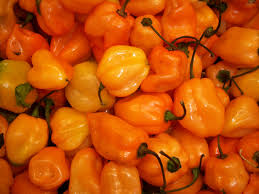
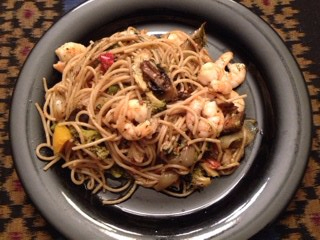
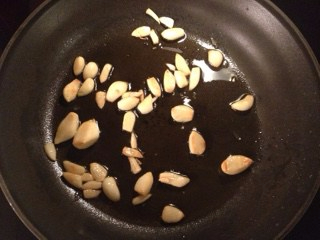 Sometimes figuring out what to do for a late, last-minute Saturday dinner when nothing comes to mind because you don’t seem to have anything that hangs together can be daunting, like pushing a boulder uphill or keeping up with The New Yorker. But these situations yield success by virtue of necessity. Foraging in the fridge and freezer revealed little more than some leftover pasta (spaghetti, I cooked way too much on Thursday) and a few frozen shrimp. It’s all you need if you have a few other things on hand. Try this:
Sometimes figuring out what to do for a late, last-minute Saturday dinner when nothing comes to mind because you don’t seem to have anything that hangs together can be daunting, like pushing a boulder uphill or keeping up with The New Yorker. But these situations yield success by virtue of necessity. Foraging in the fridge and freezer revealed little more than some leftover pasta (spaghetti, I cooked way too much on Thursday) and a few frozen shrimp. It’s all you need if you have a few other things on hand. Try this: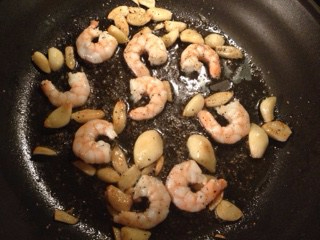 Peel a couple of heads of garlic (heads, not cloves) and put them into some olive oil. Sauté just until they begin to turn golden-brown (never overcook garlic). Toss in some shrimp and sauté just until they begin to show a little color (never overcook seafood of any kind). Finally, put in some leftover pasta and cheese (any hard cheese) and toss around until toasty.
Peel a couple of heads of garlic (heads, not cloves) and put them into some olive oil. Sauté just until they begin to turn golden-brown (never overcook garlic). Toss in some shrimp and sauté just until they begin to show a little color (never overcook seafood of any kind). Finally, put in some leftover pasta and cheese (any hard cheese) and toss around until toasty.


 A friend from out of state visited us in New Jersey. Having recently returned from Greece, we were still infatuated with the food there and decided to make dolmas and spanakopita with garlic roasted potatoes (although we didn’t consume any of these foods in Greece). Concerned about boiling the baby in the mother’s milk, I wondered if my observant friend could have my homemade tzatziki with dinner. “No problem,” he announced, I’ll just eat the spanakopita with tzatziki first, and then eat the dolmas. Reminded at this moment of these food rules I couldn’t decide if I found this response to be absurd or hilarious. One thing I knew for sure is that I regarded rules like this with contempt. Then things went bad. Upon observing that my egg-lemon sauce contained both butter and chicken stock my friend explained that it would be “for you all to enjoy, not me.” To me, this was unforgivable, a transgression I couldn’t overlook and one that still haunts me today. Egg-lemon sauce in my world has one job—singular and precious—and that’s to be ladled over dolmas (OK, and grilled salmon and asparagus). That any soul, in any world, isn’t allowed to drench dolmas in that nearly golden sauce is criminal. No, it goes beyond criminality and into transcendentalism. For me, it poses a fundamental question: is being Kosher really worth it in this world or any other? And I’m not even going into the obvious fact that the pig is the single greatest animal to eat, at least in this world. Maybe I’ll understand it one day. But I doubt it. If pigs rule the afterworld, I will be at peace in purgatory.
A friend from out of state visited us in New Jersey. Having recently returned from Greece, we were still infatuated with the food there and decided to make dolmas and spanakopita with garlic roasted potatoes (although we didn’t consume any of these foods in Greece). Concerned about boiling the baby in the mother’s milk, I wondered if my observant friend could have my homemade tzatziki with dinner. “No problem,” he announced, I’ll just eat the spanakopita with tzatziki first, and then eat the dolmas. Reminded at this moment of these food rules I couldn’t decide if I found this response to be absurd or hilarious. One thing I knew for sure is that I regarded rules like this with contempt. Then things went bad. Upon observing that my egg-lemon sauce contained both butter and chicken stock my friend explained that it would be “for you all to enjoy, not me.” To me, this was unforgivable, a transgression I couldn’t overlook and one that still haunts me today. Egg-lemon sauce in my world has one job—singular and precious—and that’s to be ladled over dolmas (OK, and grilled salmon and asparagus). That any soul, in any world, isn’t allowed to drench dolmas in that nearly golden sauce is criminal. No, it goes beyond criminality and into transcendentalism. For me, it poses a fundamental question: is being Kosher really worth it in this world or any other? And I’m not even going into the obvious fact that the pig is the single greatest animal to eat, at least in this world. Maybe I’ll understand it one day. But I doubt it. If pigs rule the afterworld, I will be at peace in purgatory. And there are other problems. While Bill Buford observes that vegetarians actually think more about meat and where it comes from than do carnivores (whom tend to think about meat as “an element in a meal . . . [e.g.] ‘what I want tonight is a cheeseburger!’”), there is still confusion lurking just under the veg surface. Kel and I went to have drinks and avocados with friends. We had vodka and they drank wine and beer. Two of them had just returned from Montreal. We were excited to ask them the typical questions. How was the train ride? How was the bed and breakfast? How was the exchange rate? Was it expensive? We asked about those kinds of things. But we were saving the most important and exciting question for last. “Talk about the food,” I requested dramatically. Five seconds into their answer, and I remember it like it was yesterday, they disclosed that they had recently “become” vegetarian. Almost reflexively I checked out of the conversation and worried that my disdain would be too obvious and rude as they went on about the “vegetarian Japanese restaurant” that they enjoyed and the other, meatless products they consumed. Vegetarian Japanese? Aren’t the Japanese best known for their seafood, beef, and pork? Their response had suddenly become stultifying, my frustration at this point tangible. What better way to make a food story uninteresting than by eliminating the eating of animals from it? I can’t really think of one.
And there are other problems. While Bill Buford observes that vegetarians actually think more about meat and where it comes from than do carnivores (whom tend to think about meat as “an element in a meal . . . [e.g.] ‘what I want tonight is a cheeseburger!’”), there is still confusion lurking just under the veg surface. Kel and I went to have drinks and avocados with friends. We had vodka and they drank wine and beer. Two of them had just returned from Montreal. We were excited to ask them the typical questions. How was the train ride? How was the bed and breakfast? How was the exchange rate? Was it expensive? We asked about those kinds of things. But we were saving the most important and exciting question for last. “Talk about the food,” I requested dramatically. Five seconds into their answer, and I remember it like it was yesterday, they disclosed that they had recently “become” vegetarian. Almost reflexively I checked out of the conversation and worried that my disdain would be too obvious and rude as they went on about the “vegetarian Japanese restaurant” that they enjoyed and the other, meatless products they consumed. Vegetarian Japanese? Aren’t the Japanese best known for their seafood, beef, and pork? Their response had suddenly become stultifying, my frustration at this point tangible. What better way to make a food story uninteresting than by eliminating the eating of animals from it? I can’t really think of one. Finally, vegetarianism in its most fanatical form is called “veganism.” This fantastical human invention is a very small step away from not eating at all. I recognize that this is a realm of theory and practice that exists in another dimension entirely—familiar to only a tiny fraction of a percentile of people on earth—and one that I’ll never understand. But I also recognize that there must be a reason that no civilization (that I’ve ever heard of) has ever survived by eating like this. Like vegetarianism often is, this orientation to food is the product of a bourgeois condition that fails to see the moral repugnancy of turning your nose up at any food. I disdain veganism for the same reason I disdain eating competitions. Both show an utter disrespect for food and hungry people. Animals and their byproducts are our most cherished and important friends because we eat them. And the idea that “true” vegans refuse to eat honey, for example, because it’s made by bees? I rest my case and will stop ranting . . . for now.
Finally, vegetarianism in its most fanatical form is called “veganism.” This fantastical human invention is a very small step away from not eating at all. I recognize that this is a realm of theory and practice that exists in another dimension entirely—familiar to only a tiny fraction of a percentile of people on earth—and one that I’ll never understand. But I also recognize that there must be a reason that no civilization (that I’ve ever heard of) has ever survived by eating like this. Like vegetarianism often is, this orientation to food is the product of a bourgeois condition that fails to see the moral repugnancy of turning your nose up at any food. I disdain veganism for the same reason I disdain eating competitions. Both show an utter disrespect for food and hungry people. Animals and their byproducts are our most cherished and important friends because we eat them. And the idea that “true” vegans refuse to eat honey, for example, because it’s made by bees? I rest my case and will stop ranting . . . for now.